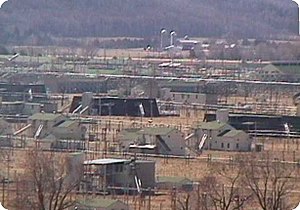Badger Army Ammunition Plant
| Badger Army Ammunition Plant | |
|---|---|
| Sauk County, near Sauk City, Wisconsin | |

General view toward west, Badger Army Ammunition Plant before demolition
|
|
| Coordinates | 43°22′05″N 89°45′14″W / 43.368°N 89.754°WCoordinates: 43°22′05″N 89°45′14″W / 43.368°N 89.754°W |
| Site history | |
| Built | 1942 |
| In use | World War II, Korean War, Vietnam War |
The Badger Army Ammunition Plant (BAAP or Badger) or Badger Ordnance Works (B.O.W.) is an excess, non-BRAC, United States Army facility located near Baraboo, Wisconsin. It manufactured nitrocellulose-based propellants during World War II, the Korean War, and the Vietnam War. It was the largest munitions factory in the world during World War II. As of 2013, the facility was in the end stages of demolition and remediation in preparation for property transfer.
On 29 October 1941, U.S. Representative William H. Stevenson announced the construction of a powder and acid works to be built by Hercules Powder Company. On 19 November 1941, despite protests from those living on Sauk Prairie, President Franklin D. Roosevelt authorized $65,000,000 to build the plant. By 1 March 1942, the farmers who lived there had left their farms.
Construction of Badger Ordnance Works, as it was known in World War II, began in March 1942. Before the works were built, a 75,000 foot fence was erected around approximately 7,500 acres (30 km2) of the 10,500 acres (42 km2) acquired by the U.S. Army. When the plant was finished, it contained smokeless powder and rocket grain production facilities, housing for 12,000 construction workers and their families for six months, housing for 4,000-8,000 production workers and their families for the length of World War II, a school, a recreation center, a child care facility, a hospital, cafeterias, and a transportation system. By December 1942, 24 miles (39 km) of standard gauge railroad were completed.
Within the first ten months of construction, the first production area went into operation. The plans originally called for production lines to make smokeless powder, diphenylamine, and sulfuric acid. In the end, the facility's production lines included smokeless powder, acid, sulfuric acid, rocket propellant, and Ball Powder.
...
Wikipedia
